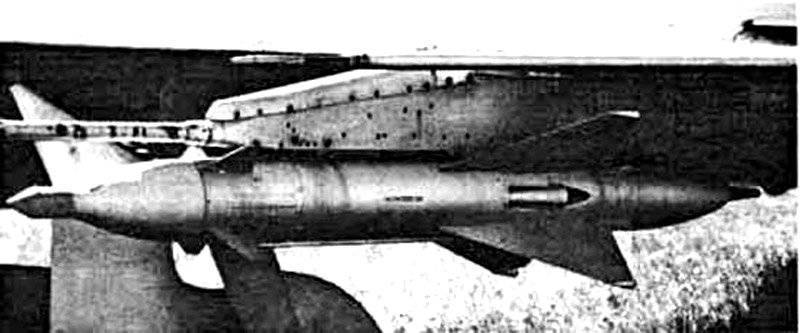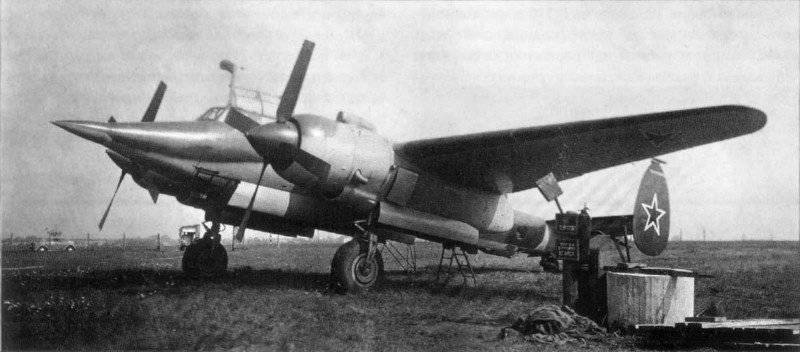Aviation homing missile SNARS-250 (USSR)
The development of ammunition began as a research project. SNARS was positioned as a missile / air-to-air missile. The work was carried out according to the resolution of the Council of Ministers of the Soviet Union No. 1175-400 from 14.04.1948 in the design office of the plant No. 293 (in our time, ICB Molniya), the work manager M. Bisnovat. The deadline for the draft design is scheduled for autumn 1948 of the year. However, due to the novelty and complexity of development, the deadline was not met. Until the end of the year, there were problems with the project documentation and the rest of the project participants - SRI-85 and Plant No. 40. The finished integrated technical project was ready for the spring 1949 of the year. Begin aerodynamic testing of models of SNARS in different layouts and air tests of models of "product 12 and 14". Samples of automatic rockets are created under the name “20 object” with the installation of aircraft equipment. Completed work on the synthesis of design documentation.
According to the technical specification, the weight of the projectile should not exceed 300 kilogram, the explosive weight of the warhead - no more than 20 kilogram. Estimated speed on 10 kilometers - about 400 m / s, high-altitude ceiling - up to 15 kilometers. The maneuverability of the homing projectile must be ensured at the level of existing fighters. The probability of hitting the target - at the level of 75 percent direct hits. The launch range is 5 kilometers (while providing a projectile with a thermal head for enemy jet aircraft). For conventional aircraft, the projectile, provided with a radar head, had an 3 kilometer range (GOS capture range).

The ammunition received an aerodynamic "duck" scheme with diamond-shaped wings and trapezoidal rudders. At first, SNARS-250 received the name of the product I-64, the flying model was known as the product 9. Models equipped with liquid-propellant rocket engines, known under the product names 12 and 14, were created to determine the shape of the tail and wing.
Projectile homing was developed almost from scratch, ready-made solutions in this area did not exist at that time. Work on the creation of a semi-active radar-type seeker has been entrusted to the SRI-17 MAP. The heat head was commissioned by the 2 SCR (CCB-393). By the way, according to the thermal head, ready-made developments were already in place - it was created for a self-guided type Crab aerial bomb. Autopilot commissioned to create a specialist plant 118. Solid-fuel rocket engine was commissioned to create specialists 81 plant.
The work performed and experimental developments were recognized as successful. December 4.12.1950, XNUMX was given the go-ahead for the transition to experimental and design work. The caliber of the homing projectile "air-to-air" as adopted in aviationclosely related to the weight of the ammunition. Two such ammunition for the MiG-15 almost completely correspond to the payload.
But at the preliminary stage of development, it becomes clear to designers that the weight of the homing projectile will exceed the required one. This immediately called into question the use of ammunition on the most common Soviet fighter aircraft, despite the fact that it was still necessary to install an airborne radar aboard an interceptor fighter. As a carrier aircraft, they chose a Tu-2 capable of taking on a large payload.

In 1951, 10 was scheduled to launch homing missiles with radar and thermal heads. From 1952, factory tests of 3 batches, the total number of 60 ammunition, were scheduled. It was planned to increase the maximum range of the radar-type seeker to 5 kilometers, the thermal heads were left at the level of the required characteristics. Ammunition speed should have been increased to 500 m / s. The main carriers planned new 2-x motor interceptors I-320 and La-200.
In the 1951 year, 20 ammunition with different types of GPS was ready, but there were no launches from carriers this year - the GPS and autopilot were not fully tested. Two Tu-2 aircraft began flying with suspended ammunition on hangers. Mainly they worked out on-board equipment and telemetry, which was placed on balloons like VAZ-1.

In May, 1952 began autonomous ammunition launches. Of the four launches, half went well.
August 1952 of the year. Starts SNARS with thermal seeker "0-3". The ammunition was launched to target in the direction of the Moon, but only one (first) of the 6 ammunition successfully went in the direction of the “target”. Were identified deficiencies of thermal seeker on the angle of capture, rudder and pitch. September 1952 of the year, ammunition starts with a radar seeker called "Strike". Of all the launches, only one was recognized as successful - the target was at a distance of 4.5 kilometer, and SNARS successfully aimed at the target and passed to 11 meters from it (the specified triggering radius of the proximity-type fuse was equal to 25 meters). Again the same flaws came to light - the rudders of the pitch and the course were constantly wedged. Flight tests are interrupted to refine the equipment and aggregates of the SNARS.
At 1952, the radio-fuse and on-board battery were not modified. The main culprit, which led to jamming of the rudders, became the autopilot AP-27. Affected by a small amount of autonomous test data ammunition. In addition, the developer (293 plant) clearly did not have time to work in two directions - on SNARS-250 and Storm. There was a significant shortage of specialists at the plant, especially in the areas of autopilot, control systems, radar and IR equipment. The plant tried to increase the number of specialists and requested fifty young specialists in 1951, but received only a dozen people. In 1952, the intensity of work was reduced by prioritizing the work of KB-1 — work was required on the anti-aircraft Berkut and the aviation G-300 (one of the heads of KB-1 was Beria’s son).
In 1953, eight launches of converted SNARS-250 munitions were scheduled. However, the 19.02.1953 of the year team of specialists under the leadership of Bisnovata, as CBs are eliminated and transferred to KB-1. But after a few months (the death of I.Stalin), KB-1 also falls under the reformatting. Work is underway on the restoration of the design bureau under the leadership of Bisnovat and the restoration of work on CHAP-250. However, time was lost and SNARS in technical characteristics becomes "obsolete". In addition, La-200 and I-320 were never.
In 1953, work began on the development of K-15, which was superior in performance to both SNARS and its carriers. In 1954, work began on the development of K-6 / 7 / 8 aircraft missiles for various fighters of the Soviet Union.
Specialists headed by M. Bisnovat were organized into a new OKB - OKB-4 and began to engage in new tasks. Work on SNARS-250 no longer conducted by anyone.
Key Features:
- Length - 4.2 meters;
- diameter - 32 centimeter;
- wing - 1.5 meter;
- engine - solid propellant rocket motor, thrust 1220 kilogram;
- engine operation - 9 seconds;
Information sources:
http://militaryrussia.ru/blog/topic-2.html
http://www.airwar.ru/weapon/avv/snars-250.html
http://www.missiles.ru/k8.htm
Information